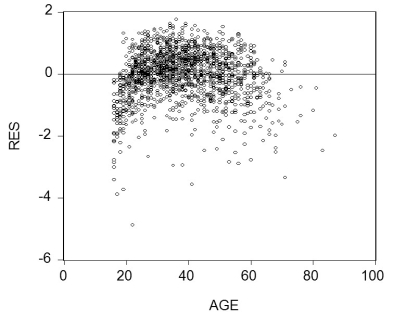You have learned that earnings functions are one of the most investigated relationships in economics.These typically relate the logarithm of earnings to a series of explanatory variables such as education,work experience,gender,race,etc.
(a)Why do you think that researchers have preferred a log-linear specification over a linear specification? In addition to the interpretation of the slope coefficients,also think about the distribution of the error term.
(b)To establish age-earnings profiles,you regress ln(Earn)on Age,where Earn is weekly earnings in dollars,and Age is in years.Plotting the residuals of the regression against age for 1,744 individuals looks as shown in the figure:  Do you sense a problem?
Do you sense a problem?
(c)You decide,given your knowledge of age-earning profiles,to allow the regression line to differ for the below and above 40 years age category.Accordingly you create a binary variable,Dage,that takes the value one for age 39 and below,and is zero otherwise.Estimating the earnings equation results in the following output (using heteroskedasticity-robust standard errors):  = 6.92 - 3.13 × Dage - 0.019 × Age + 0.085 × (Dage × Age),R2=0.20,SER =0.721.
= 6.92 - 3.13 × Dage - 0.019 × Age + 0.085 × (Dage × Age),R2=0.20,SER =0.721.
(38.33)(0.22)(0.004)(0.005)
Sketch both regression lines: one for the age category 39 years and under,and one for 40 and above.Does it make sense to have a negative sign on the Age coefficient? Predict the ln(earnings)for a 30 year old and a 50 year old.What is the percentage difference between these two?
(d)The F-statistic for the hypothesis that both slopes and intercepts are the same is 124.43.Can you reject the null hypothesis?
(e)What other functional forms should you consider?
Definitions:
Gasoline Taxes
Taxes imposed by governments on the sale of gasoline, often used to fund transportation infrastructure.
Benefits-Received Principle
A taxation principle where taxes are allocated according to the level of benefits received by the taxpayer.
Redistribution
The process by which income and wealth are reallocated across society, often through taxation and government spending to reduce economic inequalities.
Federal Government Outlays
Refers to the total spending by the federal government, including spending on goods and services, transfer payments, and interest on the debt.
Q7: In order to calculate the slope,the intercept,and
Q10: One of your peers wants to analyze
Q11: An estimator <img src="https://d2lvgg3v3hfg70.cloudfront.net/TB2833/.jpg" alt="An estimator
Q13: FAS 133 defines effective hedging as<br>A)a hedge
Q33: A foreign currency long hedge with a
Q35: A binary variable is often called a<br>A)dummy
Q49: In order to calculate the regression R2
Q53: Let <img src="https://d2lvgg3v3hfg70.cloudfront.net/TB2833/.jpg" alt="Let be
Q58: (Requires calculus. )Let Y be a Bernoulli
Q58: Find the market value of a plain